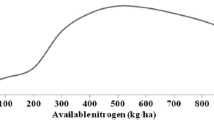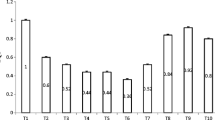Abstract
The sustainable use of agricultural lands is significantly affected by the implemented management and land processing methods. In sugar beet and wheat cropping, because the agronomic characteristics of plants are different, the tillage methods applied also exhibit significant variability. Soil quality concept is used, as a holistic approach to determining the effects of these applications on the sustainable use of soil. Agricultural soil quality evaluation is essential for economic success and environmental stability in rapidly developing regions. At present, a variety of methods are used to evaluate soil quality using different indicators. This study was conducted in one of the most important irrigated agriculture areas of Çumra plain in Central Anatolia, Turkey. In the soil under sugar beet and wheat cultivation, 12 soil quality indicators (aggregate stability (AS), available water capacity (AWC), surface penetration resistance (PR0–20), subsurface penetration resistance (PR20–40), organic matter (OM), active carbon (AC), potentially mineralizable nitrogen (PMN), root health value (RHV), pH, available phosphorus (AP), potassium (K), and macro-micro elements (ME) (Mg, Fe, Mn, and Zn)) were measured and scored according to the Cornell Soil Health Assessment (CSHA) and the Soil Management Assessment Framework (SMAF). The differences among 8 (AS, AWC, PR0–20, PR20–40, AC, PMN, AP, and ME) of these 12 soil quality characteristics measured in two different plant cultivation were found statistically significant. The result of the soil quality evaluation with scoring function in the examined area revealed a soil quality score of 61.46 in the wheat area and of 51.20 in the sugar beet area, which can be classified as medium and low, respectively. Low soil quality scores especially depend on physical and biological soil properties. Therefore, improvement of soil physical and biological properties with sustainable management is necessary to enhance the soil quality in the study area soils.



Similar content being viewed by others
References
Acton, D., & Gregorich, L. (1995). Understanding soil health. The health of our soils: toward sustainable agriculture in Canada., 5–10.
Adeyolanu, O. D., Are, K. S., Oluwatosin, G. A., Ayoola, O. T., & Adelana, A. O. (2013). Evaluation of two methods of soil quality assessment as influenced by slash and burn in tropical rainforest ecology of Nigeria. Archives of Agronomy and Soil Science, 59(12), 1725–1742.
Andrews, S. S., & Carroll, C. R. (2001). Designing a soil quality assessment tool for sustainable agroecosystem management. Ecological Applications, 11(6), 1573–1585.
Andrews, S. S., Karlen, D. L., & Cambardella, C. A. (2004). The soil management assessment framework. Soil Science Society of America Journal, 68(6), 1945–1962.
Bal, L., Şeker, C., & Gümüş, İ. E. (2011). Kaymak Tabakası Oluşumuna Fiziko-Kimyasal Faktörlerin Etkileri. Selçuk Tarım Bilimleri Dergisi, 25(3), 96–103.
Benintende, S., Benintende, M., Sterren, M., Saluzzio, M., & Barbagelata, P. (2015). Biological variables as soil quality indicators: effect of sampling time and ability to classify soils by their suitability. Ecological Indicators, 52, 147–152.
Birkás, M., Jolánkai, M., Gyuricza, C., & Percze, A. (2004). Tillage effects on compaction, earthworms and other soil quality indicators in Hungary. Soil and Tillage Research, 78(2), 185–196.
Blair, G. J., Lefroy, R. D., & Lisle, L. (1995). Soil carbon fractions based on their degree of oxidation, and the development of a carbon management index for agricultural systems. Crop and Pasture Science, 46(7), 1459–1466.
Cambardella, C., Moorman, T., Andrews, S., & Karlen, D. (2004). Watershed-scale assessment of soil quality in the loess hills of southwest Iowa. Soil and Tillage Research, 78(2), 237–247.
Craig, A., & Arlene, J. (2002). Soil quaity field tools: experi-ences of USDA-NRCS soil quality institilte. Agronomy Journal, 94, 33–38.
D’Hose, T., Cougnon, M., De Vliegher, A., Vandecasteele, B., Viaene, N., Cornelis, W., et al. (2014). The positive relationship between soil quality and crop production: A case study on the effect of farm compost application. Applied Soil Ecology, 75, 189–198.
De Meester, T. (1970). Soils of the Great Konya Basin, Turkey. Agric. Res. Rep, 740, 290.
Doran, J. W., & Jones, A. J. (1996). Methods for assessing soil quality: Soil Science Society of America Inc.
Doran, J. W., & Parkin, T. B. (1994). Defining and assessing soil quality. Defining soil quality for a sustainable environment(definingsoilqua), 1–21.
Eyüpoğlu, F. (1999). Türkiye topraklarının verimlilik durumu: TC Başbakanlık Köy Hizmetleri Genel Müdürlüğü.
FAO (1990). Micronutrient assessment at the country level p 1–208: An international study (Ed., M. Sillanpa). FAO Soil Bulletin 63. Published by FAO, Rome.
Gee, G., & Bauder, J. (1986). Particle-size analysis In: Klute, A.(ed) Methods of soil analysis, Part 1. American society of Agronomy. Inc., Ma.
Govaerts, B., Sayre, K. D., & Deckers, J. (2006). A minimum data set for soil quality assessment of wheat and maize cropping in the highlands of Mexico. Soil and Tillage Research, 87(2), 163–174.
Gugino, B. K., Abawi, G. S., Idowu, O. J., Schindelbeck, R. R., Smith, L. L., Thies, J. E., et al. (2009). Cornell soil health assessment training manual: Cornell University College of Agriculture and Life Sciences.
Güçdemir, İ. (2006). Türkiye gübre ve gübreleme rehberi. Tarım ve Köyişleri Bakanlığı, Tarımsal Araştırmalar Genel Müdürlüğü, Toprak ve Gübre Araştırma Enstitüsü Müdürlüğü, Ankara.
Kacar, B. (2009). Toprak analizleri: Nobel Yayın Dağıtım.
Karlen, D., Andrews, S. S., Wienhold, B. J., & Zobeck, T. M. (2008). Soil quality assessment: past, present and future. Electronic Journal of Integrative Biosciences, 6(1), 3–14.
Karlen, D., Ditzler, C. A., & Andrews, S. S. (2003). Soil quality: why and how? Geoderma, 114(3), 145–156.
Karlen, D., Gardner, J., & Rosek, M. (1998). A soil quality framework for evaluating the impact of CRP. Journal of Production Agriculture, 11(1), 56–60.
Karlen, D., Mausbach, M., Doran, J., Cline, R., Harris, R., & Schuman, G. (1997). Soil quality: a concept, definition, and framework for evaluation (a guest editorial). Soil Science Society of America Journal, 61(1), 4–10.
Karlen, D., Stott, D., Cambardella, C., Kremer, R., King, K., & McCarty, G. (2014). Surface soil quality in five midwestern cropland conservation effects assessment project watersheds. Journal of Soil and Water Conservation, 69(5), 393–401.
Karlen, D., Wollenhaupt, N. C., Erbach, D., Berry, E., Swan, J., Eash, N. S., et al. (1994). Crop residue effects on soil quality following 10-years of no-till corn. Soil and Tillage Research, 31(2), 149–167.
Klingebiel, A., & Montgomery, P. (1961). Land-capability classification. In Soil conservation service, Agricultural handbook. No. 210. Washington DC: US Department of Agriculture.
Klute, A. (1986). Water retention: laboratory methods. Methods of soil analysis: part 1—physical and mineralogical methods(methodsofsoilan1), 635–662.
Larson, W. E., & Pierce, F. J. (1994). The dynamics of soil quality as a measure of sustainable management. In: Doran, J. W. (Ed.), Defining Soil Quality for a Sustainable Environment. Soil Science Society of America Special Publication No. 35. Madison: Soil Science Society of America and American Society of Agronomy, pp. 37–51.
Liebig, M., Tanaka, D., & Wienhold, B. J. (2004). Tillage and cropping effects on soil quality indicators in the northern Great Plains. Soil and Tillage Research, 78(2), 131–141.
Lindsay, W., & Norvell, W. (1969). Development of a DTPA micronutrient soil test. In Agron. Abstr, 84, 1–11.
Meester, T. d. (1970). Soils of the Great Konya Basin, Turkiye: Wageningen: Pudoc, Centre for Agricultural Publishing and Documentation.
Meester, T. d. (1971). Highly calcareous lacustrine soils in the Great Konya Basin, Turkey. Pudoc, Wageningen, The Netherlands.
Nael, M., Khademi, H., & Hajabbasi, M. (2004). Response of soil quality indicators and their spatial variability to land degradation in Central Iran. Applied Soil Ecology, 27(3), 221–232.
Nakajima, T., Lal, R., & Jiang, S. (2015). Soil quality index of a crosby silt loam in central Ohio. Soil and Tillage Research, 146, 323–328.
Olsen, S., Sommers, L., & Page, A. (1982). Methods of soil analysis. Part 2. Agron. Monogr, 9, 403–430.
Ozgoz, E., Gunal, H., Acir, N., Gokmen, F., Birol, M., & Budak, M. (2013). Soil quality and spatial variability assessment of land use effects in a typic haplustoll. Land Degradation & Development, 24(3), 277–286.
Pierce, F. J., & Larson, W. (1993) Developing criteria to evaluate sustainable land management. In Proceedings of the Eighth International Soil Management Workshop: Utilization of Soil survey Information for Sustainable Land Use (pp. 7–14)
Rashidi, M., Seilsepour, M., Ranjbar, I., Gholami, M., & Abbassi, S. (2010). Evaluation of some soil quality indicators in the Varamin region, Iran. World Applied Sciences Journal, 9(1), 101–108.
Sacco, D., Moretti, B., Monaco, S., & Grignani, C. (2015). Six-year transition from conventional to organic farming: effects on crop production and soil quality. European Journal of Agronomy, 69, 10–20.
Seybold, C., Mausbach, M., Karlen, D., & Rogers, H. (1997). Quantification of soil quality. Soil processes and the carbon cycle, 387–404.
Şeker, C., & Işıldar, A. (2000). Tarla trafiğinin toprak profilindeki gözenekliliğe ve sıkışmaya etkisi. Turkish Journal of Agriculture and Forestry, 24, 71–77.
Şeker, C., & Karakaplan, S. (1999). Relationships of modulus of rupture to soil properties in Konya plain. Turkish Journal of Agriculture and Forestry, 23(2), 183–190.
Wright, A. F., & Bailey, J. S. (2001). Organic carbon, total carbon, and total nitrogen determinations in soils of variable calcium carbonate contents using a Leco CN-2000 dry combustion analyzer. Communications in Soil Science and Plant Analysis, 32(19–20), 3243–3258.
Yakowitz, D., Stone, J., Lane, L., Heilman, P., Masterson, J., Abolt, J., et al. (1993). A decision support system for evaluating the effects of alternative farm management systems on water quality and economics. Water Science and Technology, 28(3–5), 47–54.
Yao, R.-J., Yang, J.-S., Zhang, T.-J., Gao, P., Yu, S.-P., & Wang, X.-P. (2013). Short-term effect of cultivation and crop rotation systems on soil quality indicators in a coastal newly reclaimed farming area. Journal of Soils and Sediments, 13(8), 1335–1350.
Acknowledgements
This study was taken from a research project supported by TUBITAK (Scientific and Technological Research Council of Turkey, Project No.: TOVAG 112O314) and Selcuk University (S.U.) BAP Office (Coordinating Office of Scientific Research Projects, Project No.: 09201086). The authors would like to thank “the TUBITAK and S.U.-BAP staffs”.
Author information
Authors and Affiliations
Corresponding author
Rights and permissions
About this article
Cite this article
Şeker, C., Özaytekin, H.H., Negiş, H. et al. Assessment of soil quality index for wheat and sugar beet cropping systems on an entisol in Central Anatolia. Environ Monit Assess 189, 135 (2017). https://doi.org/10.1007/s10661-017-5848-z
Received:
Accepted:
Published:
DOI: https://doi.org/10.1007/s10661-017-5848-z




